Scientific name Banksia petiolaris | Genus Banksia Section Banksia sect. Banksia Rank Species | |
 | ||
Similar Banksia blechnifolia, Banksia repens, Banksia gardneri, Banksia pilostylis, Banksia caleyi | ||
Banksia petiolaris is a species of shrub of the genus Banksia in the family Proteaceae. It is a prostrate banksia, a group of several closely related species all with horizontal stems and thick, leathery upright leaves. No varieties have been subsequently described. It bears yellow inflorescences in spring. It is found in sandy soils in the south coastal regions of Western Australia in the vicinity of Esperance. It is nonlignotuberous, regenerating by seed after bushfire. Banksia petiolaris adapts readily to cultivation, and is suitable for rockeries and as a groundcover.
Contents
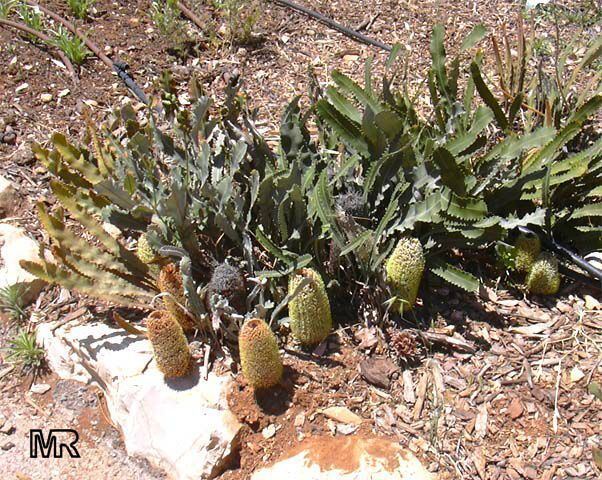
Description
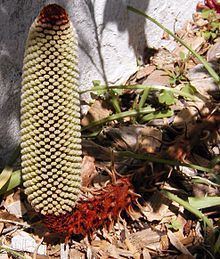
Banksia petiolaris is a prostrate shrub which can spread to a diameter of 2 metres (6.6 feet), its thick stems grow horizontally on the ground and are covered in fine hair. The new growth is more densely covered with velvety orange brown hair. The large leathery upright leaves arise vertically on petioles up to 15 cm (6 in) high. The adaxial surface faces north and is inclined at around 15 degrees off vertical. The leaf laminae can reach 60 cm (23.5 in) in length and 4 cm (1.5 in) wide. They are dull green with serrated margins and a white undersurface. Dead leaves remain on the plant. Flowering occurs in late spring. The cylindrical inflorescences are yellow in overall colour and range from 9 to 16 cm (3.5 to 6.5 in) high. As the flower spikes age, they fade to a greyish colour, the old flowers persisting. Up to 20 follicles may appear on each spike. Covered with a fine grey fur, they are elliptical in shape and measure 2.8–3.8 cm (1.1–1.5 in) in length, and 1.5–2 cm (0.59–0.79 in) in width.
It is nonlignotuberous, regenerating by seed after bushfire.
Taxonomy
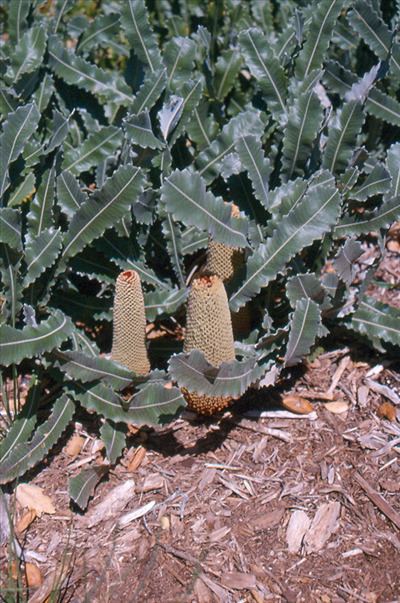
Banksia petiolaris was first described by Victorian state botanist Ferdinand von Mueller in 1864, its specific name Latin for "with petioles". The type specimen was most likely collected in 1861 by G. Maxwell between Cape Le Grand and Cape Arid and is housed in Melbourne. No further subspecies or varieties of B. petiolaris have been described, and it has no taxonomic synonyms. Its only nomenclatural synonym is Sirmuellera petiolaris (F.Muell.) Kuntze, which arose from Otto Kuntze's unsuccessful 1891 attempt to transfer Banksia into the new name Sirmuellera.
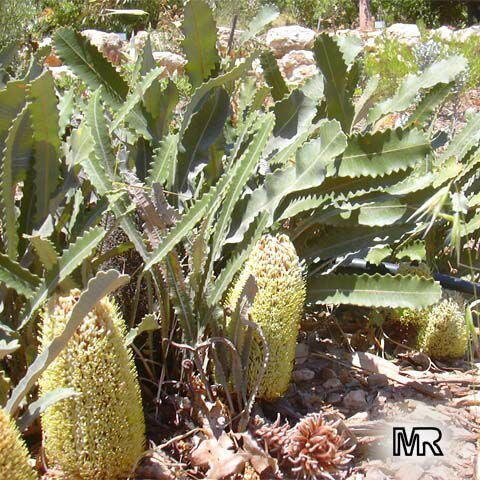
It is one of six closely related species in section Banksia ser. Prostratae, all endemic to Western Australia, and all with a prostrate habit. George holds it as closely related to B. blechnifolia.
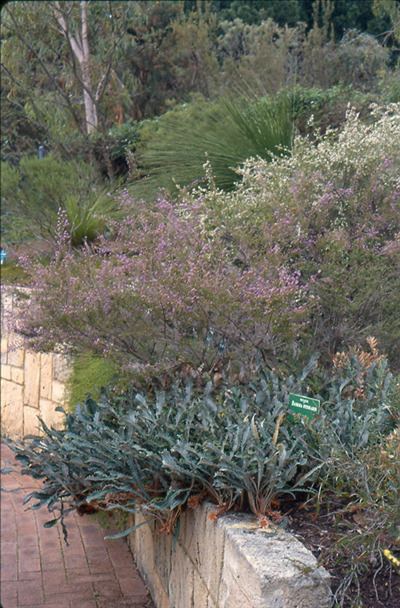
In 1996, botanists Kevin Thiele and Pauline Ladiges published an arrangement informed by a cladistic analysis of morphological characteristics. Their arrangement maintained B. petiolaris in B. subg. Banksia and series Prostratae. They found it to be basal (the earliest offshoot) to the other prostrate banksias. Questioning the emphasis on cladistics in Thiele and Ladiges' arrangement, George published a slightly modified version of his 1981 arrangement in his 1999 treatment of Banksia for the Flora of Australia series of monographs. To date, this remains the most recent comprehensive arrangement. The placement of B. petiolaris in George's 1999 arrangement may be summarised as follows:
BanksiaB. subg. BanksiaB. sect. BanksiaB. ser. Salicinae (11 species, 7 subspecies)B. ser. Grandes (2 species)B. ser. Banksia (8 species)B. ser. CrocinaeB. ser. Prostratae (6 species, 3 varieties)B. goodiiB. gardneriB. gardneri var. gardneriB. gardneri var. brevidentataB. gardneri var. hiemalisB. chamaephytonB. repensB. blechnifoliaB. petiolarisB. ser. Cyrtostylis (13 species)B. ser. Tetragonae (3 species)B. ser. Bauerinae (1 species)B. ser. Quercinae (2 species)B. sect. Coccinea (1 species)B. sect. Oncostylis (4 series, 22 species, 4 subspecies, 11 varieties)B. subg. Isostylis (3 species)Since 1998, American botanist Austin Mast has been publishing results of ongoing cladistic analyses of DNA sequence data for the subtribe Banksiinae, which includes Banksia. With respect to B. petiolaris, Mast's results have some semblance to George and Thiele's. It is somewhat basal in a group with the other prostrate species as well as species in series Tetragonae, and B. elderiana, B. baueri, and B. lullfitzii. However, B. repens, B. chamaephyton and B. blechnifolia form a closely knit group within this group, and the overall inferred phylogeny is very different from George's arrangement. Early in 2007, Mast and Thiele initiated a rearrangement of Banksiinae by publishing several new names, including subgenus Spathulatae for the species of Banksia that have spoon-shaped cotyledons; in this way they also redefined the autonym B. subgenus Banksia. They have not yet published a full arrangement, but if their nomenclatural changes are taken as an interim arrangement, then B. petiolaris is placed in subgenus Banksia.
Distribution and habitat
Endemic to Western Australia, Banksia petiolaris is found near the state's south coast from the vicinity of Munglinup east to Israelite Bay, concentrated in two disjunct ranges – an eastern one around Cape Arid National Park, and western one east of Scaddan. It is found in white sandy soils in heathland (kwongan) or mallee-heath, but sometimes occurs with the taller Banksia speciosa.
Ecology
Like other banksias, B. petiolaris plays host to a variety of pollinators – insects such as bees, wasps and ants were all recorded in the 1988 The Banksia Atlas survey.
An assessment of the potential impact of climate change on this species found that its range is likely to contract by between 30% and 80% by 2080, depending on the severity of the change.
Banksia petiolaris has the longest-lived angiosperm leaves so far recorded – a study published in 1992 recorded a lifespan of up to 13 years for a single leaf, while leaves of 10 years of age ably maintained their ability to photosynthesize compared with young leaves. The authors concluded that leaf longevity is advantageous in plants in nutrient poor soils, as the loss of valuable nutrients in leaf loss is minimised (the leaves store much of a plants' nutrients).
Cultivation
Although somewhat resistant to dieback, it does require a well drained soil, preferably fairly sandy. Like other banksias, it grows best in full sun. It makes an attractive prostrate groundcover, and can be used in embankments and to reduce soil erosion, as well as rockeries. It is tolerant of alkaline soils, with one cultivated specimen recorded tolerating a pH of 9.5. Seeds do not require any treatment, and takes about 18 to 49 days to germinate.
